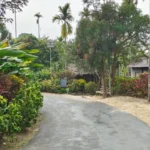This time on your Goa tour travel to a place far far away and so off the radar that you might just be the only one. The village of Curdi is one of those rare and quirky gems of India, that was once a bustling village, but now is a ghost town. This village was fully functional till 1983, till it was submerged by the Salaulim Dam. The quirky part? The village is underwater for about 11 months, not 12. So, you can visit this village just as the water comes down in peak summers- early June or end of May, which is just before the monsoon hits Goa.
You can still find some ruined houses, temples, stages etc. that all stay underwater for 11 months, however, they are still standing tall and almost like a ghost resurface when the water is low enough.
To visit this village on your Goa tour, you have to be extremely vigilant. You can visit it in the second half of May. Each year the water levels react differently, so one year you might be able to see the entire village, whereas in the next year it might be a little under the water still.
On your Goa tour, the village of Curdi will revel you with some fascinating stories and legends. The Curdi village was home to the classical singer- Mogubai Kurdikar, who had also received Padma Vibhushan.
She was the pride of Curdi, so much so when the submerged village does rise above the water in the summer month, visitors try and visit her home first.
One of the most famous structures that you will come face to face with is the Salaulim Dam. There is a narrow road that will lead you to a huge open ground. From there you can see some water. If you can keep concentrating, you might also notice some ruins in a mud bed. While you won’t be able to make out anything, you can see the ruins.
Keep walking towards the ruins, while being extremely careful since the mud is still moist. Just walk cautiously and you will find the ruins staring at you. There are half-built walls, that perhaps belonged to someone’s house. You might also see a faint straight line, which will tell you about a road and the houses that dotted the sides.
As you move forward you might also notice coconut trees, just stubs of them. These little stubs even have cobwebs on them, giving an eerie vibe.
As you keep walking on your Goa tour in Curdi, you will pass a deep gorge that cuts through rock. This is called the Khariz. Another popular attraction, it is not known whether the Khariz is a natural waterway or man-made.
Eventually, you will come across the tall temple of Someshwar Mahadev. The flags are newly painted and you can still smell the fresh paint that swirls in the air.
After passing the temple, you will come across the Paaz. This path leads up to the Kushavati River. In this region, you will find some of the densest ruins of Curdi.
Here you can find the ruins of a stage, that was perhaps used for performances and plays. You might also notice a carved terracotta piece, door jambs and wooden brackets that were gradually eroding.
You will eventually come across Magubai Kurdikar’s home as well, which is still under the water. However, you might be able to make out a thin faint line that softy rises above the water. You can only see this when the water starts to go down quite a bit.
There is also the Mand, where the Curdi Utsav takes place.
While Goa is filled with churches, the village of Curdi revolves around temples. On your Goa tour in Curdi, you will find quite a few shrines that you can visit.
This is perhaps the major temple in the Curdi village. This lovely shrine is made up of two floors, and the presiding deity is a Shivalinga known as Someshwar. The Sri Someshwar Temple cannot be moved according to the locals.
As you wander into the temple on your Goa Tour, you will find a photo of the original temple that once existed here. The original temple was much bigger than what it is now. You should ask the locals about the temple timings, to double-check.
There is a gorgeous obelisk or Deepstambha which has signs of erosion, which shows the signs of being underwater. However, the temple is still standing in all its pride and glory.
There are two arched doors, and a music room, which was perhaps for the musicians and dancers to performed their art here.
Once you exit the temple, just look around you. It is quite haunting. Some hills dot the background, whose reflections sway with the currents of the water.
There is also an annual festival called Curdi Utsav, which was started by the original locals of the village. You can try and schedule your Goa tour according to the festival.
This ancient temple is quite a historic monument in Curdi. This temple was moved stone by stone to a place closer to the iconic Salaulim Dam. It was moved by ASI themselves and it is quite commendable on their part.
On your Goa Tour in Curdi, you will also find few remote and hidden caves. There are quite a few rock-cut caves, and you have to be determined enough to locate them. It is not easy, however, if you do locate them, you will not only feel that sense of achievement but also discover something that very few people can.
Visiting the Curdi Village on your Goa Tour is not only different but will also show you a hauntingly beautiful place that few people know about. This village will make you feel all kinds of things. While the scenery is gorgeous, the ruins will truly make you feel for the people who lived here. Just stare as long as you can, and let this ruined city come alive in your imagination.

Best Places to Visit in Dubai with Kids
02 Jul 2025
India’s Finest Luxury Retreats: The Ultimate Hotel & Resort Collection
01 Jul 2025
Taj Holidays’ Wildlife Retreats: Where Nature Roars and Luxury Whispers
30 Jun 2025
10 Indian Art Forms You Can Experience During Travel
29 Jun 2025
12 Most Beautiful Villages in India Worth Visiting
28 Jun 2025